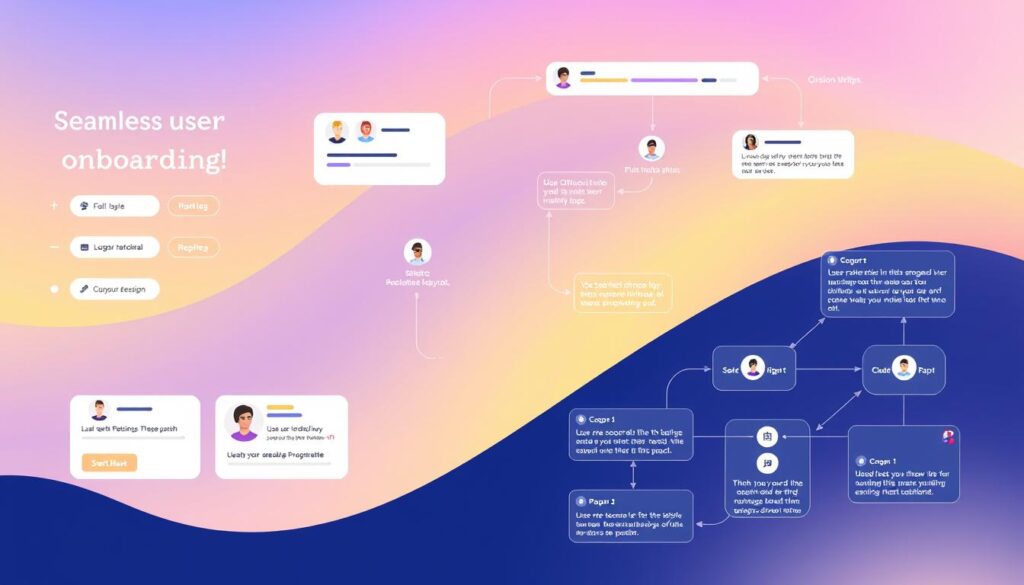Onboarding flows are the first impression users get of your product, setting the tone for their entire experience. A well-designed onboarding process introduces users to key features and helps them understand the value your product brings. This fosters engagement and retention.
Onboarding flows can transform first-time visitors into loyal advocates by seamlessly guiding them and eliminating friction.
Keep reading to discover actionable tips and strategies for creating onboarding flows that truly resonate with your users.
Understanding Onboarding Flows
Onboarding flows introduce users to a product and help them find value quickly. They aim to increase user activation and engagement and keep customers coming back. These flows use interactive guides, tooltips, and pop-ups to showcase key features.
Good onboarding boosts user engagement and can lead to more customers over time. It helps users find their “aha moment” faster, which speeds up activation. Studies show that people remember 65% of information with images and text, compared to just 10% with text alone.
Automating workflow in onboarding makes the process smoother and better for users. For instance, creating effective user flows for mobile apps can make tasks easier, increasing satisfaction. Personalized experiences based on user preferences or roles can also improve engagement and retention.
It’s important to keep onboarding flows short and to the point. Research shows that product tour completion rates drop from 72% to 45% after just three steps. Clear messaging and a tailored experience can help drive user engagement and keep customers for the long haul.
Types of Onboarding Flows
Different onboarding flows cater to diverse user needs. Here are some effective types:
- Interactive Tutorials: Slack uses empty states and a friendly bot to guide users through key features in real-time, helping them learn by doing.
- Guided Tours: Apps like Miro introduce users to core functions step-by-step, which is ideal for more complex tools.
- Value-First Onboarding: Duolingo and Wise demonstrate their product’s value upfront, delaying account creation to encourage user exploration.
- Self-Exploration: MyFitnessPal and Binance allow users to navigate independently while offering optional guidance.
These examples show how different onboarding flows can boost user engagement and satisfaction.
Designing an Effective Onboarding Flow
A well-designed onboarding flow is crucial for user success. To create one:
- Keep it simple: Limit the flow to seven steps or fewer to avoid overwhelming users.
- Incorporate visuals: Use clear imagery and concise language to maintain engagement.
- Include progress indicators: Checklists or progress bars help users track their journey.
- Offer flexibility: Allow users to skip or revisit steps, giving them a sense of control.
Analytics are essential for refining your onboarding flow. By tracking user behavior, you can identify pain points and make necessary adjustments. Effective onboarding can lead to a 70% reduction in support, as seen in Slack’s improved process. This not only enhances user experience but also reduces operational costs.
Remember to include progress indicators, clear language, and motivational imagery in your design. Giving users the option to skip certain steps provides a sense of control. By focusing on these elements, you can create an onboarding flow that drives user engagement and long-term retention.
Best Practices for Onboarding Flows
Creating effective onboarding flows is key for keeping users engaged and loyal. With SaaS churn rates high, guiding new users to their second login is crucial. Personalization is essential in this process. It helps tailor the experience to each user’s needs, boosting satisfaction and loyalty.
Simplicity is vital in onboarding design. Slack shows how to keep it simple and intuitive. By focusing on core features, users quickly see the product’s value. This approach helps in reducing churn by improving user engagement.
Progress indicators are great motivators. Checklists and progress bars help users feel accomplished. This, combined with personalization, can greatly improve activation rates and time-to-value. Avoiding common mistakes in user flow is crucial for creating seamless digital experiences that users love.
Common Mistakes To Avoid in Onboarding
Onboarding is key to a good customer journey and user experience. Yet, many companies struggle with it. A shocking 44% of workers leave within 6 months because of bad training or unclear job guidelines. This shows how important it is to improve onboarding.
One big mistake is giving users too much information at once. Product tours that are too detailed can confuse people. Also, ignoring user feedback can mean missing chances to improve. Companies should aim to give just enough information to help users without overwhelming them.
Another error is that onboarding does not match user goals. This can lead to a bad user experience. A Gallup study found that only 12% of employees feel their company needs to do better at onboarding. This shows a big problem in how well companies onboard new hires.
To avoid these mistakes, focus on the user. Make the onboarding process fit the user’s specific goals. Remember, 89% of consumers are more likely to buy again after a good experience. By avoiding these common errors, companies can improve onboarding and user happiness.
Tools and Technologies for Onboarding
In today’s digital world, getting users started right is key. A huge 77% of users won’t come back if they find software hard to use at first. Below are some of the key tools and technologies that can help streamline the onboarding process.
- Userpilot: A platform offering custom UI patterns and personalized onboarding experiences. Pricing starts at $249 per month.
- UXCam: An analytics tool providing insights through funnel analysis, session replays, and heatmaps to help identify user drop-offs and improve onboarding.
- In-App Engagement Tools: Tools designed to engage users directly within the application during onboarding.
- Email Automation: Tools to automate communication with users during the onboarding process.
- Video Tutorials: Video-based onboarding solutions to help guide users through the product features and functionalities.
By using these tools, businesses can create a more effective and personalized onboarding experience. This leads to higher user satisfaction and long-term engagement.

Measuring the Success of Onboarding Flows
It’s key to track how well onboarding flows work. Companies use analytics to check important metrics, which show whether users are adapting to their products well.
Data integration is important. It helps mix different data sources for a full view.
Time to Value (TTV) is a big deal. It shows how fast users see product benefits. A quicker TTV means happier users who stick around longer.
The user activation rate is also key. It shows how many users hit important product milestones.
Product adoption rate is another important metric. It compares new active users to total sign-ups. This shows how well users use product features.
Product stickiness is about daily versus monthly active users. It shows how engaging the product is over time.
Support tickets can highlight onboarding issues. Fewer tickets mean a smoother experience. The trial-to-paid conversion rate is also crucial. It shows how many free users become paying customers.
User surveys give direct feedback on the onboarding experience. The Customer Effort Score (CES) measures how easy it is to use the product. All these metrics help companies improve their onboarding flows.

Case Studies of Successful Onboarding Flows
Many companies have perfected the art of user onboarding, making customer journeys smooth. Slack is a great example. They use a friendly chatbot to guide new users through interactive walkthroughs. This helps users quickly understand the platform’s main features, improving their experience.
Grammarly’s onboarding approach is “learn by doing.” As users write, the app suggests corrections and improvements. This hands-on method lets users see the product’s value right away, speeding up their journey to the “aha moment.”
Flipboard personalizes news feeds during onboarding to engage new users. They tailor content to each user’s interests, creating a unique experience. This strategy boosts user retention and engagement.
Room platform saw impressive results after using Userpilot for onboarding. They saw a 75% increase in CV upload volume in just two weeks. This shows how effective onboarding can drive user actions and improve key metrics. Optimizing onboarding flows can lead to big improvements in user activation and engagement.
Future Trends in Onboarding Flows
The future of onboarding flows is exciting. It will bring better user engagement through automation and personalization. AI and machine learning are making onboarding smarter and more adaptable. They will help companies create journeys that fit each user’s needs and actions in real-time.
Gamification is becoming a big player in onboarding. It can make users try out products more and buy them more often. By using psychology, gamification makes the start of using a product more fun and encouraging.
Data-driven personalization is key to good onboarding. Companies like Keboola have seen big improvements. With tailored flows, they’ve sped up onboarding by 29% and cut support tickets by 70%. This trend will keep growing, with AI offering more ways to personalize the user experience.
Contextual and self-serve guidance is also on the rise. It’s beating traditional tours in completion rates by 123%. As users want more control over learning, we’ll see more onboarding flows that fit each user’s style and pace.
Final Thoughts: Elevating User Onboarding for Success With Mood Joy
Onboarding flows are more than just a starting point. They’re a powerful tool for shaping a user’s journey and ensuring their long-term success.
By prioritizing simplicity, personalization, and clarity, businesses can create flows that guide users effectively. This approach also helps build confidence and trust in their products.
When paired with thoughtful design, robust analytics, and continuous improvement, onboarding flows can significantly enhance engagement, minimize churn, and cultivate user loyalty. They’re not just a process but a cornerstone of a successful user experience strategy.
But onboarding is just the beginning. From intuitive navigation to engaging micro-interactions, every design choice influences how users connect with your product.
Ready to take your UX/UI expertise to new heights? Discover more actionable insights and expert advice on Mood Joy — your go-to resource for mastering exceptional user experience design.



